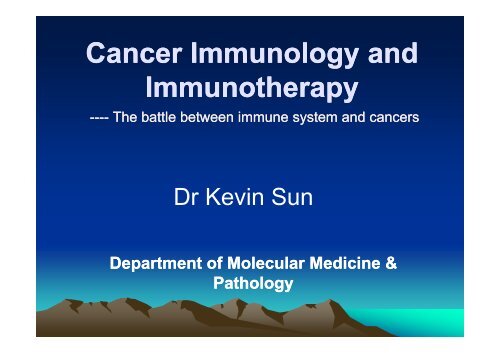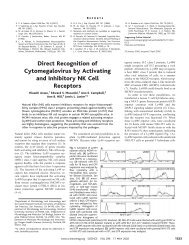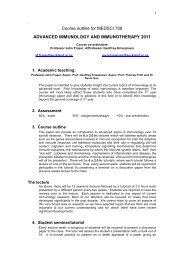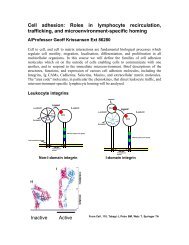TUMOR IMMUNOLOGY.pdf
TUMOR IMMUNOLOGY.pdf
TUMOR IMMUNOLOGY.pdf
You also want an ePaper? Increase the reach of your titles
YUMPU automatically turns print PDFs into web optimized ePapers that Google loves.
Cancer Immunology and<br />
Immunotherapy<br />
---- The battle between immune system and cancers<br />
Dr Kevin Sun<br />
Department of Molecular Medicine &<br />
Pathology
Basic knowledge of cancer<br />
• What is Cancer<br />
• How does cancer occur<br />
• How many types of cancers<br />
• Current therapeutic strategies for cancers
Definitions of Cancer<br />
• Cancer consists of single clones or several<br />
clones of cells that are capable of<br />
independent growth in the host.<br />
• Cancer cells arise from host cells via<br />
neoplastic transformation or carcinogenesis.<br />
• Physical, chemical and biological agents<br />
y , g g<br />
may cause cancer. -- carcinogens
Carcinogens<br />
• Radiation: Ultraviolet light, sunshine; X-rays,<br />
radioactive elements induce DNA damage and<br />
chromosome brakes.<br />
• Chemical: smoke and tar, countless chemicals<br />
that damage DNA (mutagens).<br />
• Oncogenic viruses: insert DNA or cDNA copies<br />
of viral oncogens into the genome of host target<br />
cells.<br />
• Hereditary: certain oncogenes are inheritable.
Neoplastic Transformation<br />
-- Carcinogenesis<br />
• Activate growth regulatory genes: Growth factor<br />
receptors (erbA, -B, fims, neu); molecules of signal<br />
transduction (src, abl, ras); transcription factors (jun,<br />
fos ,myc)- referred to as oncogenes.<br />
• Genes that inhibit growth: (p53 controls DNA repair<br />
and cell proliferation; Rb)-suppressor oncogenes.<br />
• Genes that t regulate apoptosis: bl2 bcl-2, Bax, Bid.
Classification of cancer<br />
• Carcinoma: epithelial origin involving the skin,<br />
mucous membranes, epithelial cells in glands<br />
• Sarcoma: cancer of connective tissue, i.e.<br />
liposarcoma, fibrosarcoma<br />
• Lymphoma: T-cell, B-cell, Hodgkin’s s, Burkitt’s<br />
lymphomas; - solid tumors<br />
• Leukemia: disseminated tumors - lymphoid,<br />
myeloid, acute and chronic
Current strategies to combat<br />
cancers<br />
• Mechanics<br />
-- surgery,1600BC<br />
• Physics<br />
-- radiotherapy,1896<br />
• Chemistry -- chemotherapy,1942<br />
• Biology -- immunotherapy,1976
Advantages of Immunotherapy<br />
for cancer<br />
• Cancer cells are immunogenic<br />
• Single cell kill<br />
• Migrate to tissue<br />
• Memory<br />
• Specific<br />
• Life-long protection
Cancer Immunology and<br />
Immunotherapy
• How does the immune system eliminate cancer cells<br />
• How do cancer cells escape from Immunosurveilance<br />
• How can we help to win the battle between immune<br />
system and cancers – Cancer immunotherapy<br />
• Examples
Cancer Immunosurveilance<br />
• The hypothesis was first proposed by Ehrlich h in<br />
1909, and modified by Thomas and Burnet in<br />
1957.<br />
• Immunosurveilance: the immunological<br />
resistance of the host against the development of<br />
cancer.<br />
• Now referred to “cancer immunoediting”<br />
encompassing 3 phases: elimination, equilibrium<br />
and escape.
Cells of the Immune System<br />
Bone graft<br />
Macrophage<br />
Mast cell<br />
Marrow<br />
Eosinophil<br />
Erythrocytes<br />
Basophil<br />
Bone<br />
Hematopoietic<br />
stem cell<br />
Monocyte<br />
Megakaryocyte<br />
Multipotential<br />
stem cell<br />
Myeloid<br />
progenitor<br />
cell<br />
Neutrophil<br />
Platelets<br />
l t<br />
Lymphoid progenitor cell<br />
T lymphocyte<br />
Dendritic cell<br />
Natural killer cell<br />
B lymphocyte
Army of the host to fight cancers<br />
Antibody<br />
Macrophage<br />
Cancer cell<br />
Helper T cell<br />
cytokine<br />
NK cell<br />
chemokine<br />
Dendritic cell<br />
Cytotoxic T cell
Cytotoxic T cells (CTLs)<br />
CD8+ T cells: attaching to class I MHC -<br />
peptide complex, they destroy cancer cells<br />
by perforating the membrane with<br />
enzymes or by triggering an apoptotic<br />
pathway.<br />
Surface<br />
contact<br />
Release of<br />
enzymes
Helper T cells<br />
CD4+ T cells: reacting to class II MHCpeptide<br />
p complex, they secret cytokines.<br />
cytotoxic T cell response (Th1 helper T cells)<br />
antibody response (Th2 helper T cells)<br />
Logistics force
Dendritic Cells<br />
The professional antigen-presenting cells In the<br />
final common pathway for activating naïve T<br />
cells.<br />
Dendritic<br />
cell<br />
T cell<br />
A novel subset of dendritic cells [IFN-producing killer DC] (IKDC):<br />
TRAIL& perforin- tumor cell lysis; via T cell; IFNγ-angiogenesisγ g<br />
-- Early Warning Aircraft
Other cells<br />
NK cells: after activation, directly killing tumor cell<br />
NKT cells: TRAIL/perforin- tumor cell lysis;<br />
IFNγ-angiogenesis<br />
Macrophages: antigen presenting<br />
NK cell<br />
NKT cell<br />
Macrophage
Cytokines<br />
• Regulating the innate immune system: NK cells,<br />
macrophages, and neutrophils; and the adaptive immune<br />
system: T and B cells<br />
• IFN-α α -- upregulating MHC class I, tumor antigens, and<br />
adhesion molecules; promoting activity of B and T cells,<br />
macrophages, and dendritic cells.<br />
• IL-2 -- T cell growth factor that binds to a specific tripartite<br />
receptor on T cells.<br />
• IL-12 – promoting NK and T cell activity, and a growth factor<br />
for B cells<br />
• GM-CSF (Granulocyte-monocyte o colony o stimulating factor) ) --<br />
reconstituting antigen-presenting cells.
Antibody - produced by B cells<br />
• Direct attack: blocking growth factor receptors, arresting<br />
proliferation of tumor cells, or inducing apoptosis.<br />
-- is not usually sufficient to completely protect the body.<br />
• Indirect attack: -- major protective efforts<br />
(1) ADCC (antibody-dependent( cell mediated cytotoxicity y )<br />
-- recruiting cells that have cytotoxicity, such as monocytes and<br />
macrophages.<br />
(2) CDC (complement dependent cytotoxicity)<br />
-- binding to receptor, initiating the complement system,<br />
'complement cascade’, resulting in a membrane attack<br />
complex, causing cell lysis and death.<br />
Heavy chain<br />
Light chain<br />
Constant region<br />
Antigen-binding<br />
region<br />
Assembled antibody molecule<br />
-- missile
Tumor elimination
How does cancer<br />
Single<br />
cancer cell<br />
progress<br />
Escape<br />
Advanced cancer
Cancer<br />
Immunology/Immunotherapy<br />
• How does the immune system eliminate cancer cells<br />
• How do cancer cells escape from Immunosurveilance<br />
• How can we help to win the battle between immune<br />
system and cancers – Cancer immunotherapy<br />
• Examples
Mechanisms of cancer escape from<br />
the Immunosurveilance<br />
1. Altering Their Characteristics ti :<br />
Loss/downregulation of MHC class I<br />
Down-regulation regulation, mutation, or loss of tumor antigens<br />
Loss of costimulation<br />
2. Suppressing the Immune Response :<br />
ineffective signals to CTL<br />
Alteration in cell death receptor signaling<br />
Immunosuppressive cytokine<br />
3. Outpacing the Immune Response: Tumour cells<br />
can simply pyproliferate so quickly that the immune<br />
response is not fast enough to keep their growth<br />
in check
How cancer cells avoid<br />
immunosurveillance<br />
1. Weapons from tumors<br />
2. Defects of immune system<br />
stem
(1) Loss/down-regulation of HLA<br />
class I (MHC I)<br />
• Total loss: β2 microglobulin mutation, alteration in<br />
antigen processing machinery<br />
• Haplotype loss: LOH in chromosome 6<br />
• HLA allelic loss: mutations of HLA class I genes<br />
• HLA-A, B, C locus down-regulation: alteration of<br />
transcriptional factors<br />
• Compound phenotype: 2 or more independent<br />
mechanisms
(2) Down-regulation, mutation or loss of<br />
tumor antigens<br />
Tumor antigens (TA)<br />
Tumor associated antigen (TAA)<br />
• Complete loss<br />
• Down-modulation
Tumor Antigens<br />
• Altered self: K-ras, products of normally unexpressed<br />
genes (MAGE, BAGE, GAGE), proteins of alternative<br />
reading frame, - of post-translational modification, -<br />
different orders of glycosylation gy y (mucin-CA125,, MUC1).<br />
• Viral antigens: EBNA, E-6,E-7, papilloma virus antigens<br />
of cervical carcinomas.<br />
• Oncofetal antigens: alpha-fetoprotein (AFP),<br />
Carcinoembryonic antigen (CEA)<br />
• Autoantigens: overexpression - c-myc in lymphomas,<br />
leukemias; HER-2/neu epidermal growth factor receptorbreast<br />
cancer (Herceptin).
(3) Loss of costimulation<br />
Costimulatory molecules recognized:<br />
B7.1(CD80)<br />
B7.2(CD86)<br />
CD40 L<br />
CD27, CD30<br />
4-1BB<br />
OX40<br />
ICAM-1<br />
B7 family
T cell Activation<br />
T cell<br />
No Activation<br />
T cell<br />
CD28 TCR CD28 CD28 TCR<br />
CD28<br />
B7.1 B7.2<br />
Peptide/<br />
MHC<br />
APC<br />
Peptide/<br />
MHC<br />
APC<br />
Co-stimulation<br />
Loss of costimulation
The initiation of T cell responses requires two<br />
distinct signals<br />
X
(4) Alterations in cell death<br />
receptor signalling<br />
• Defects in Fas/FasL signaling system:<br />
resistance to apoptosis<br />
• Apoptosis resistance: overexpression<br />
of Bcl-2
(5) Immunosuppressive<br />
cytokines<br />
• a number of immunosuppressive cytokines.<br />
• IL-10 inhibits antigen presentation and IL-12<br />
production.<br />
• TGF-beta induces overproduction of IL-10.<br />
• VEGF (vascular endothelial growth factor),<br />
avoid immune recognition, inhibit the<br />
effector function, prevent T cell activation,<br />
cytokine production.
(6) Induction of<br />
Immunosuppressive cells<br />
• CD4+CD25+ T cells (constitute 5-10% of CD4+ T cells):<br />
immunological tolerance to self-antigens, inhibition of T cell<br />
proliferation.<br />
• Gr1+CD11b+ myeloid cells:<br />
-- Expressing the granulocyte-monocyte markers Gr1+CD11b+,<br />
accumulate in spleens, lymph nodes and blood of tumorbearing<br />
mice.<br />
-- Inhibiting antibody production, CTL generation, T cell<br />
function, lymphocytic proliferation, CD3 ζ chain expression.
Regulatory T Cells<br />
T cells compete<br />
T cells compete for<br />
for same antigen<br />
cytokine signals<br />
Cytotoxic<br />
T cell<br />
Mature<br />
dendritic<br />
cell<br />
Regulatory<br />
T cell<br />
Regulatory<br />
T cells<br />
Proliferation
Potential<br />
sources for<br />
regulatory<br />
T cells
Possible suppressive mechanisms regulatory T cells
(7) Production of other<br />
suppressive factors<br />
• IDO (Indoleamine 2, 3-dioxygenase):<br />
expressed in most human tumour tissues<br />
and splenic DC subsets, leading to<br />
blockage of proliferation of T cells<br />
• ganglioside (sialic acid containing<br />
glycosphingolipids)<br />
• Prostaglandins
Summary: Main defences of the<br />
tumors against immunity<br />
1) Alteration of MHC class I and tumor antigen expression<br />
2) Dysregulated expression of adhesion / costimulatory<br />
molecules by tumor and/or antigen-presenting cells<br />
3) Changes in T-cell signal transduction molecules, i.e. cell death<br />
receptor signalling<br />
4) Induction of immune suppressive cytokines<br />
5) Induction of immunosuppressive cells<br />
6) Secretion of suppressive factors
1. Weapons from the tumors<br />
2. Defects of immune system
• Immune defects in T cells<br />
• Malfunction of dendritic cell system
Immune defects in T cells in cancer<br />
• Alterations in the expression of signal transduction<br />
molecules in immune cells.<br />
• Loss of CD 3ζ chain. TCR-CD3 complex. It functions<br />
as a single transducer upon antigen binding.<br />
• Receptor-mediated apoptosis of T cells contributes to<br />
T cell dysfunction.
Tumor mass<br />
Vessel<br />
Lymphocyte<br />
FasL+ tumor cell<br />
Apoptotic lymphocyte<br />
Receptor-mediated apoptosis of lymphocytes
Malfunction of dendritic cell system<br />
– Tumor-mediated inhibition of DC generation,<br />
differentiation and maturation<br />
– Functional impairment of DCs: lack of<br />
expression of costimulatory molecules<br />
– Induction of DC apoptosis by tumors
Tumor-derived factors with DC inhibitory properties<br />
Tumor-derived factors Effect on DCs<br />
VEGF<br />
TGF-beta<br />
Gangliosides<br />
IL-6<br />
IL-10<br />
Prostanoids,prostaglandins<br />
PgE2<br />
NO<br />
tumor infiltration and generation<br />
CD80 and CD86 expression<br />
inhibition of dendropoiesis from<br />
hematopoietic precursor cells<br />
differentiation<br />
differentiation,CD80/CD86/CD40<br />
expression,IL-12 production<br />
differentiation<br />
generation<br />
induction of apoptosis
Summary<br />
How do tumors progress
Activation versus suppression of<br />
immunity during tumor progression<br />
Cytokines<br />
Tumor<br />
Regression<br />
Tumor<br />
T cell<br />
Activation ><br />
suppression<br />
Suppression<br />
> activation<br />
NK cell<br />
DC<br />
Tumor<br />
Progression
The fortune of tumor cells<br />
depends on the battle between<br />
immune system and tumor cells
The defense of tumor overweighs the anti-<br />
tumor immunity<br />
it<br />
Cytotoxic CD8 cells<br />
Dendritic cells<br />
Macrophages<br />
Cytokines<br />
Antibodies<br />
Antigen/MHC loss<br />
T-cell dysfunction<br />
Suppressive cytokine<br />
Suppressive T cells<br />
Overweighing effector cells<br />
Balance
Cancer<br />
Immunology/Immunotherapy<br />
• How does the immune system eliminate cancer cells<br />
• How do cancer cells escape from Immunosurveilance<br />
• How can we help to win the battle between immune<br />
system and cancers – Cancer immunotherapy<br />
• Examples
Tumor Immunotherapy<br />
Strategies to improve the tumor-<br />
associated immune response by<br />
either boosting components of the<br />
immune system that produce an<br />
effective immune response or by<br />
inhibiting components that suppress<br />
the immune response.
Immunotherapy --- Reverse<br />
the imbalance<br />
Tumor Immunotherapy<br />
Tumor Progression
Strategies to supplement the missing or<br />
insufficient immune elements<br />
Immune elements Enhancing ‘the enhancer’<br />
T cells<br />
Dendritic Cells<br />
Natural killer cells<br />
TAA<br />
Effector cytokines<br />
Injection of cytotoxic T cells<br />
DC vaccination<br />
Injection of activated NK cells<br />
Peptide, TAA-vector vaccination<br />
IL-2, IL-12
Strategies to block the suppressive sive<br />
mechanisms<br />
Suppressive elements Inhibiting ‘the inhibitors’<br />
Regulatory T cells Blocking their function<br />
dysfunctional DCs<br />
Suppressive cytokines<br />
Blocking the pathway<br />
Blocking potential common<br />
cytokine signalling<br />
Suppressive factors Blocking their function
Main Mechanisms of<br />
Immunotherapy<br />
• Stimulating the antitumor response, either by increasing<br />
the number of effector cells or by producing soluble<br />
mediators.<br />
• Decreasing suppressor mechanisms.<br />
• Altering tumor cells to increase their immunogenicity and<br />
make them more susceptible to immunologic defences.<br />
• Improving tolerance to cytotoxic drugs or radiotherapy,<br />
p g y g py,<br />
such as stimulating bone marrow function with GM-CSF.
History: Non-specific approach<br />
• 1892 - WB Coley observed tumour regression<br />
after bacterial infections<br />
• BCG vaccine to treat bladder carcinoma<br />
• 1970-80’s – cytokines<br />
– includes interferons, interleukins and tumor<br />
necrosis factor (TNF)<br />
– Limited success
Current Immunotherapeutic<br />
strategies in clinic or clinical trials<br />
• Antibody Therapy<br />
• Cytokine Therapy<br />
• Adoptive Therapy<br />
• Vaccination<br />
• Combinational therapy
Examples
Antibody Therapy<br />
Rituximab: The first approved antibody by FDA in clinical trial.<br />
Targeting CD20. low-grade non-Hodgkin lymphoma
Event<br />
Discovery of IL-2<br />
Cytokine therapy<br />
-- IL-2<br />
Author<br />
Morgan et al.(1976)<br />
Mitogenic IL-2 signal and long-term cultures of tumor-specific CTL Gillis and Smith (1977)<br />
Activating IL-2 signal (LAK cells)<br />
Grimm et al.(1982)<br />
Local administration of IL-2 inhibits tumour growth<br />
in preclinical models<br />
Bubeník et al.(1983)<br />
Local administration of IL-2 inhibits growth of human tumors Pizza et al. (1984)<br />
Systemic administration of IL-2 inhibits growth of metastatic Rosenberg et al.(1985a)<br />
experimental tumours<br />
Utilization of recombinant IL-2 for clinical trials in patients<br />
with generalized tumours Rosenberg et al.(1985b)<br />
Local IL-2 gene therapy inhibits tumour growth in preclinical models Bubeník et al.(1988)<br />
Utilization of TIL or tumour cells carrying an inserted IL-2 gene Anderson (1992);<br />
for the first clinical trials<br />
Foa et al. (1992)
Local and regional IL-2 administration in cancer patients -<br />
selected examples from the early trials<br />
Interleukin-2 Dose Tumour Response (%) Reference<br />
(units/patient) ti t) Complete/partial<br />
ti l<br />
gibbon lymphoid 1.5 x 10-2 – 4.0 x 10-3 urinary bladder carcinomas 30/ 30 Pizza (1984)<br />
human recombinant 1.0 x 10-4 – 2.8 x 10-4 lung carcinomas 0/ 82 Yasumoto (1987)<br />
human recombinant 8.0 x 10-2 – 5.4 x 10-3 malignant gliomas 13/ 13 Yoshida (1988)<br />
human lymphoid 2.0 x 10-3 squamous cell carcinomas 29/ 29 Forni (1988)<br />
human lymphoid 2.0 x 10-3 squamous cell carcinomas 30/ 30 Cortesina (1988)<br />
human lymphoid continuous perfusion urinary bladder carcinomas 20/ n.v. Huland and Huland<br />
1.5 x 10-6/week (1989)<br />
n.v., not verified because of incomplete transurethral resection
Adoptive immunotherapy<br />
• Stimulating immune cells by exposing<br />
them to tumour cells or antigens in the<br />
laboratory and then injecting expanded<br />
populations of the treated cells into<br />
patients.<br />
• Patient is both donor and recipient.
Tumor escape mechanism and T-cell adoptive<br />
immunotherapy after genetic manipulation<br />
(1) Tumor cells that produce TGFß that exert inhibitory effects on the immune system. Specific CTL can be genetically<br />
modified to become resistant to the TGFβ inhibitory effect through transgene expression of a mutant dominant-<br />
negative TGFß type II receptor (DNR).<br />
(2) Specific T cells genetically modified to produce IL-12 can overcome IL-10 inhibitory effect.<br />
(3) Tumors express FasL and induce apoptosis of effector T cells. Small interfering RNA (siRNA) can be used to<br />
knock-down Fas receptor in specific CTL, allowing a significant reduction of their susceptibility to Fas/FasL-<br />
mediated apoptosis.
Adoptive immunotherapy<br />
The Journal of Clinical Investigation Vol 113 Number 11 June 2004 pp 1515<br />
Generation of dendritic cell vaccines from peripheral blood monocytes:<br />
p p y<br />
1) Monocytes cultures with GM-CSF +IL-4 to produce DCs<br />
2) Matured with CD40 ligand<br />
3) Pulsed with peptide or tumour lysate<br />
4) Re-injected as vaccine to induce T-cell immune response against tumour
Antitumor Vaccines<br />
Administration of some form<br />
of antigen to induce a specific<br />
antitumour immune response.
Antitumor Vaccines
Antitumor Vaccines
Approaches to antitumor vaccination<br />
APC – antigen presenting cell<br />
DC – dendritic cell<br />
The Journal of Clinical Investigation Vol 113 ( 11) June 2004 pp 1515<br />
TAA – tumour associated antigen<br />
MHC – major histocompatibility complex
Dendritic Cells That Attack Cancer<br />
Complex binds<br />
to dendritic cell<br />
precursor<br />
Dendritic cell<br />
matures and is<br />
infused back into<br />
patient<br />
Tumor antigen<br />
Tumor<br />
antigen is<br />
linked to a<br />
cytokine<br />
Complex is<br />
taken in by<br />
dendritic cell<br />
precursor<br />
T cell<br />
Cancer cell<br />
T cells attack cancer cell
Combinational Therapy<br />
-- a three-stranded cord is not easily broken<br />
• Combination of different immunotherapies<br />
ACT+IL-2 + costimulation<br />
• Combining immunotherapy with other<br />
therapeutic strategies
Examples from my research work
The immune system can be harnessed<br />
as a potent weapon to combat cancer,<br />
but only if immunotherapy is combined<br />
with treatment strategies that target a<br />
tumour’s weapons of survival, defence,<br />
and attack. If cancer cells are prevented<br />
from growing they will be unable to<br />
generate immune escape variants.
Gene transfer of antisense hypoxia inducible factor-1α<br />
enhances the therapeutic efficacy of cancer immunotherapy<br />
Sun X, et al. Gene Therapy 2001; 8: 638-645645
Potential mechanisms for synergy displayed by combined blocking<br />
hypoxia pathway and B7.1-mediated immunotherapy<br />
NK<br />
Apoptosis<br />
Tumor<br />
cell<br />
v<br />
v<br />
Tumor<br />
cell<br />
v<br />
Tumor<br />
cell<br />
B7.1<br />
Necrosis<br />
B7.1+AS-HIF<br />
Activates<br />
NK cells<br />
AS-HIF<br />
Anti-angiogenesis<br />
+ hsp70- tumor<br />
Antigen<br />
Glycolysis<br />
B7.1 APC MHCI<br />
CD28<br />
T cell<br />
MHCII<br />
CD28<br />
Tumor C<br />
cell<br />
B7.1<br />
MHCI<br />
T cell<br />
Proliferation<br />
& CTLmediated<br />
killing<br />
MHCII<br />
Heat-shock<br />
di driven antitumor<br />
immunity<br />
Cell vitality<br />
Immune suppressive<br />
elements<br />
Tumor<br />
Cell<br />
Apoptosis
B7H3-meidated Cancer Immunotherapy<br />
Arsenic trioxide synergizes with B7H3-mediated<br />
immunotherapy to eradicate hepatocellular carcinomas<br />
International Journal of Cancer 2006; 118:1823-1830.<br />
Complete eradication of fhepatocellular l carcinomas by combined<br />
vasostatin gene therapy and B7H3-mediated immunotherapy.<br />
Journal of Hepatology 2007;46: 98-106
Novel co-stimulatory molecule- B7H3<br />
Molecular Structure<br />
SS IgV-like IgC-like Cytoplasmic<br />
Transmembrance<br />
Signal peptide<br />
MLRGWGGPSVGVCVRTALGVLCLCLTGAVEVQVSEDPVVALVDTDATLRC<br />
IgV-like domain<br />
SFSPEPGFSLAQLNLIWQLTDTKQLVHSFTEGRDQGSAYSNRTALFPDLLVQ<br />
GNASLRLQRVRVTDEGSYTCFVSIQDFDSAAVSLQVAAPYSKPSMTLEPNK<br />
IgC-like domain<br />
DLRPGNMVTITCSSYQGYPEAEVFWKDGQGVPLTGNVTTSQMANERGLFD<br />
VHSVLRVVLGANGTYSCLVRNPVLQQDAHGSVTITGQPLTFPPEALWVTVG<br />
Transmembrane<br />
Cytoplasmic<br />
LSVCLVVLLVALAFVCWRKIKQSCEDENAGAEDQDGDGEGSKTALRPLKPS<br />
ENKEDDGQEIA<br />
Sun X, et al. Gene Therapy 2003; 10:1728-1734.
Gene transfer results in expression of B7H3 on<br />
the surface of tumor cells<br />
pcDNA3.1<br />
Flag-B7H3<br />
Flag-B7H3<br />
Tubulin
Combinational therapy led to eradication of large tumors<br />
and generation of memorized anti-tumor immunity<br />
Tumor Size<br />
(cm)<br />
2.4<br />
2<br />
16 1.6<br />
1.2<br />
0.8<br />
04 0.4<br />
B7H3+As 2<br />
O 3<br />
B7H3<br />
As 2<br />
O 3<br />
pcDNA3.1<br />
PBS<br />
0<br />
0 1 2 3 4 5 6 7 9 12<br />
Weeks After Therapy<br />
20
Production of anti-tumor cytokine and CTLs by immunotherapy<br />
Level of IFN N-γ (pg/ml)<br />
500<br />
400<br />
300<br />
200<br />
100<br />
*<br />
*<br />
Sera<br />
0 0<br />
Level of IFN N-γ (ng/ml)<br />
10<br />
8<br />
6<br />
4<br />
2<br />
* *<br />
Supernatants<br />
ity (%)<br />
Cytotoxic<br />
60<br />
50<br />
40<br />
30<br />
20<br />
10<br />
* *<br />
* *<br />
E:T Ratio<br />
20:1<br />
100:1<br />
Cytotoxicity y (%)<br />
60<br />
50<br />
40<br />
30<br />
20<br />
10<br />
* * * *<br />
PBS<br />
CD4+<br />
CD8+<br />
NK<br />
0<br />
0<br />
B7H3+As 2<br />
O 3 B7H3 PBS
Treatment of single tumor eradicates multiple distant tumors<br />
0.6<br />
cm,diam meter)<br />
Tum mor Size(<br />
0.5<br />
04 0.4<br />
0.3<br />
0.2<br />
0.1<br />
0<br />
Tumor-1,treated<br />
Tumor-2,untreated<br />
Tumor-3,untreated<br />
untreated<br />
Tumor-4,untreated<br />
Tumor-5,untreated<br />
0 1 2 3 4<br />
Weeks after therapy
Conclusion<br />
• Immunotherapy may be the next great hope for<br />
cancer treatment.<br />
• While antibodies, cytokines, and vaccines have<br />
individually shown some promise, it is likely that<br />
the best strategy to combat cancer will be to<br />
attack on all fronts.<br />
• The effect of immunotherapy in combination with<br />
traditional cancer therapies is another avenue.
Background – mini review<br />
Introduction<br />
Controversial<br />
Unclear<br />
Not reported<br />
Further investigation<br />
Shortcomings<br />
Hypothesis<br />
Experiments<br />
Discussion<br />
Materials and Methods<br />
Results<br />
Discussion<br />
Conclusion<br />
Significanceifi<br />
Combined<br />
Future Investigation
DR Kevin Sun<br />
Department of Molecular Medicine & Pathology<br />
Rm 4231<br />
Tel:3737599-85935<br />
Email:k.sun@auckland.ac.nz





